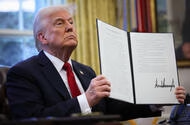Car manufacturers are currently navigating a turbulent landscape, grappling with the implications of a hefty 25% import tariff imposed by the U.S. government. For many, this sudden financial burden spells crisis, while others see it as an opportunity to recalibrate their strategies in a rapidly changing market.
How Are Automakers Responding to Tariffs?
The stakes are high. General Motors has indicated that it might face a staggering $4-5 billion hit to its profits this year. In response, the company has turned to strategies reminiscent of its pandemic-era playbook, seeking ways to cut costs and streamline operations. Meanwhile, Volkswagen is also feeling the pinch, estimating a potential profit loss of €2-4 billion. To counteract these losses, they are considering increasing production in the U.S., though the feasibility of such a move remains uncertain.
Other manufacturers, like Aston Martin and Jaguar Land Rover, have temporarily halted shipments to the U.S., having previously stocked up on models to cushion the impact of the tariffs. Mercedes-Benz has projected a significant margin reduction, estimating a loss of up to €5 billion. Stellantis, on the other hand, is taking immediate measures, including temporary shutdowns and layoffs, to safeguard its financial health.
What Are the Specifics of the Tariffs?
The tariffs, which took effect on April 3, apply to all light vehicles imported into the U.S., with a similar duty on foreign parts set to follow on May 3. While some relief is available for manufacturers producing vehicles domestically, the overall landscape remains challenging. For instance, vehicles exported from Canada and Mexico can avoid tariffs if they meet specific regional content requirements—a stipulation that has proven difficult for many German automakers.
The situation is further complicated by retaliatory tariffs from China, which have imposed a staggering 140% duty on U.S. car imports. This has effectively curtailed a lucrative market for high-margin vehicles from brands like BMW, Ford, and Mercedes, forcing them to rethink their export strategies.
Are There Long-Term Solutions?
During recent earnings calls, analysts pressed automakers for solutions to mitigate the tariff impacts. However, many executives emphasized that rebuilding production and supply chains is a long-term endeavor. Volkswagen’s CFO, Arno Antlitz, noted that while they are exploring options to increase production at their Tennessee plant, it’s still too early to determine the viability of such plans.
Mercedes, with its substantial production facility in Alabama, faces challenges not only from tariffs on exports to China but also on engines imported for SUV production. BMW’s CEO, Ola Källenius, echoed similar sentiments, highlighting the complexity of relocating established industrial structures.
What’s the Competitive Landscape?
Interestingly, the tariffs may create a competitive advantage for automakers with a more localized production footprint. General Motors and Stellantis are keenly aware of this dynamic. GM’s CEO, Mary Barra, sees a significant opportunity to leverage their U.S.-built vehicles, while Stellantis is actively looking for ways to capitalize on the tariffs to gain market share against competitors who rely heavily on imports.
As John Murphy from BofA Securities pointed out, German luxury brands and Korean manufacturers are at a disadvantage, which could allow U.S. brands like Chevrolet and Cadillac to thrive in this new environment.
What Lies Ahead?
The uncertainty surrounding these tariffs complicates strategic planning for automakers. With the Trump administration frequently altering the landscape, companies are cautious about making drastic changes too quickly. As Mercedes’ Källenius aptly noted, it’s crucial to avoid hasty decisions in such an unpredictable environment.
In the midst of this turmoil, automakers are also trying to maintain a positive relationship with the administration, with some executives expressing gratitude for support, even while forecasting significant profit losses due to the tariffs. There’s a hope among some manufacturers for potential carve-outs that could ease the burden, particularly for countries like South Korea and the UK.
As the automotive industry grapples with these challenges, the path forward remains fraught with uncertainty. However, one thing is clear: adaptability will be key. The big takeaway? Navigating these tariffs isn’t just about survival; it’s about seizing opportunities to innovate and strengthen market positions. Start with one strategic adjustment this week, and you might just find yourself ahead of the curve by the end of the month.

